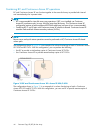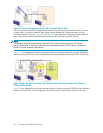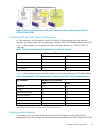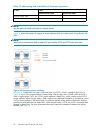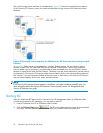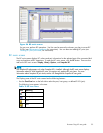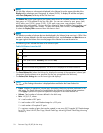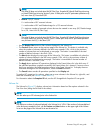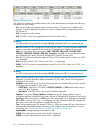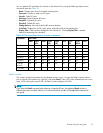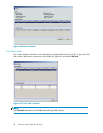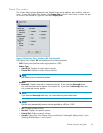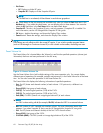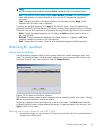
NOTE:
You can filter volumes or volume pairs displayed in the Volume list on the upper-right side of the
Display tab by selecting a port, host group, or volume (P-VOL). To display all volumes and pairs,
select Port (Subsystem) at the top of the Tree View box.
• The Volume list on the upper-right of the Display pane shows all available volumes on the port,
host group, or P-VOL selected in the Tree View box. You can sort volumes by port, group, path,
MU#, status, port (S-VOL), group (S-VOL), S-VOL path, copy pace, copy progress, volume
emulation type, and capacity. You can also filter volumes by reserve attribute, pair condition, and
pair status in the Display Filter window. To open the Display Filter window, click Display Filter,
or select the Display Filter command from the shortcut menu.
NOTE:
The maximum number of volumes that can be displayed in the Volume List at one time is 1,024. If the
number of volumes defined in the disk array exceeds this limit, use the Previous and Next buttons on
theupperrightoftheVolumelisttoturnthepagesoftheVolumelisttoseetheentirelist.
• The following icons indicate the status of a volume or pair:
Table 20 Status icons for BC
Icon LDEV status
L1 pair
L2 pair
S-VOL (node
volume: Secondary,Leafvolume:Leaf)
Reserved volume
An error occurred during operations. This error icon is displayed in the Preset Volume list.
• The Preset Volume list, below the Volume list, displays the content of the operations (volume/pair
information) that have been set or specified, but are not yet applied to the disk array.
• The Volum
e/Pair Settings box on the lower-right side displays:
NOTE:
The Volum
e/Pair Settings information is displayed above and below the Preset Volume list.
• Preset: Number of operations (volume/pair information) that have not been performed in the
disk array. The Preset Volume list, located below the Volume list, displays preset operations.
Click Apply to perform the specified operations displayed in the Preset Volume list.
• Volume: Total number of volumes defined in the disk array.
• Pairs: W(X)/Y/Z, where:
W = total number of BC pairs
X = total number of BC and ShadowImage for z/OS pairs
Y = total number of Snapshot XP pairs
Z = maximum number of pairs that can be created in one array (BC/Snapshot XP/ShadowImage
for z/OS /Auto LUN XP/Flex Copy/Hitachi FlashCopy Mirroring/Hitachi FlashCopy Mirroring
Version 2)
54
Business Copy XP (BC) for the Array



